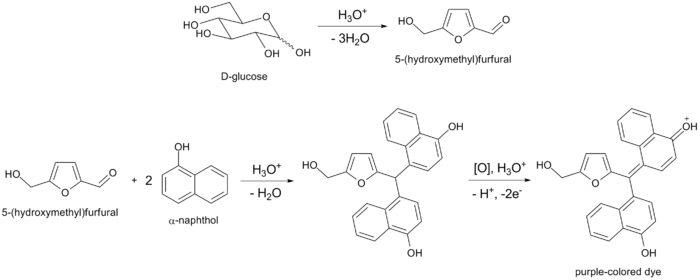Molisch's test
Molisch's test is a sensitive chemical test, named after Austrian botanist Hans Molisch, for the presence of carbohydrates, based on the dehydration of the carbohydrate by sulfuric acid or hydrochloric acid to produce an aldehyde, which condenses with two molecules of a phenol (usually α-naphthol, though other phenols such as resorcinol and thymol also give colored products), resulting in a violet ring.[1][2][3]
| Classification | Colorimetric method |
|---|---|
| Analytes | Carbohydrates |
Procedure
The test solution is combined with a small amount of Molisch's reagent (α-naphthol dissolved in ethanol) in a test tube. After mixing, a small amount of concentrated sulfuric acid is slowly added down the sides of the sloping test-tube, without mixing, to form a layer. A positive reaction is indicated by appearance of a purple red ring at the interface between the acid and test layers.[4]
Reaction
All carbohydrates – monosaccharides, disaccharides, and polysaccharides (except trioses and tetroses)– should give a positive reaction, and nucleic acids and glycoproteins also give a positive reaction, as all these compounds are eventually hydrolyzed to monosaccharides by strong mineral acids. Pentoses are then dehydrated to furfural, while hexoses are dehydrated to 5-hydroxymethylfurfural. Either of these aldehydes, if present, will condense with two molecules of α-naphthol to form a purple-colored product, as illustrated below by the example of glucose:[5]
See also
References
- John H. Foulger (1931). "The User of the Molisch (α-Naphthol) Reactions in the Study of Sugars in Biological Fluids" (PDF). J. Biol. Chem. 92: 345–353.
- Shallenberger, R (1983). "Relative stability of glucose and fructose at different acid pH". Food Chemistry. 12 (3): 159–165. doi:10.1016/0308-8146(83)90002-x. ISSN 0308-8146.
- Devor, Arthur W. (May 1950). "Carbohydrate Tests Using Sulfonated α-Naphthol". Journal of the American Chemical Society. 72 (5): 2008–2012. doi:10.1021/ja01161a037. ISSN 0002-7863.
- "Molisch's test - Medical Biochemistry". Medical Biochemistry. 2017-01-05. Retrieved 2018-09-25.
- "Molisch's Test: Objectives, Principle, Reagents, Procedure and Result -". 2018-05-01. Retrieved 2018-09-25.
